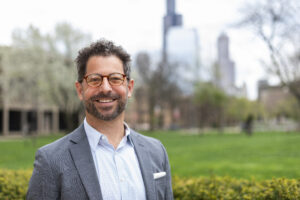The 48th Ward Zoning and Planning Committee approved a new Tax Increment Financing (TIF) district at its June 27 meeting.
While many projects can be funded through the TIF, only one was the focus of the committee, an advisory group for Ald. Mary Ann Smith (48th): Hollywood House.
Before the committee meeting began, several dozen senior citizens gathered outside of Smith’s Northside ward office to speak in favor of the TIF. The seniors live at Hollywood House, an apartment complex that provides 198 units of low-income senior housing.
Seniors like Athina Varnava, a three-year resident of Hollywood House, chanted loudly: “Vote yes on Hollywood House.”
“We want [Heartland Housing Inc.] to buy Hollywood House so there can be affordable housing for seniors here,” said Varnava. Hollywood House is currently run by the Hellenic Foundation, but funding problems have forced the organization to sell the property.
The potential buyer, Heartland Housing Inc., is a partner of the Heartland Alliance, a non-profit human rights organization. Andrew Greer, the executive director of Heartland Housing Inc., says the total development costs associated with Hollywood House would be approximately $29 million.
That’s where the TIF district comes in. Roughly a third of the tax revenue captured by the TIF, or $8 million in today’s dollars, would go to Heartland Housing Inc. The project would not be possible without the TIF money, said Greer.
The Organization of the NorthEast and Jane Addams Senior Caucus joined the seniors in support of the TIF.
“Once [Hollywood House is] gone, it’s gone forever,” said Shannon Bade, a housing organizer for the Organization of the NorthEast.
The TIF district, like all TIF districts in Chicago, will last for 23 years before it needs to be renewed.
As of Jan 1, Chicago had 147 TIF districts, according to a report by Cook County Commissioner Mike Quigley (D-10). The report said that as of 2005, the last year complete data is available, TIFs comprised 26 percent of Chicago’s area.
A TIF district works by capturing funds collected from property owners that would normally go to the city’s general fund, which pays for schools, streets and other government services.
The money diverted to this special fund is based on the increase in property tax revenue within the TIF. So, if a home owner pay $1,000 in property taxes when the TIF is created and the next year pays $1,100, then the TIF fund gets the $100. That money can be used for specific developmental projects, normally within the TIF district.
After an hour-and-a-half of discussion, motions, and points of order, and an hour after the seniors boarded a bus to return home, the committee overwhelmingly approved the TIF with only a few no votes and abstentions. Because the City Council has never rejected a request for the creation of a TIF district, approval by the committee was probably its biggest hurdle.
“It’s as close to democracy as you can get,” said Mike Volini, chairman of the committee.
The committee also approved a measure that would create an oversight committee for the new TIF, as well as the two TIFs already entirely within the 48th Ward. The oversight committee would vote on the priorities of projects funded by the TIFs.
Doug Fraser, chief of staff for Ald. Smith, said the addition of an oversight committee would be creating a precedent that would serve as a model for the rest of the city. TIF districts have been criticized in the past for, among other things, not being transparent.
“In the end, the right decision was made,” said Fraser.
Categories:
Money Matters North Side Planning & Development Public
Tags:
48th ward alderman mary ann smith edgewater tif uptown






Be First to Comment